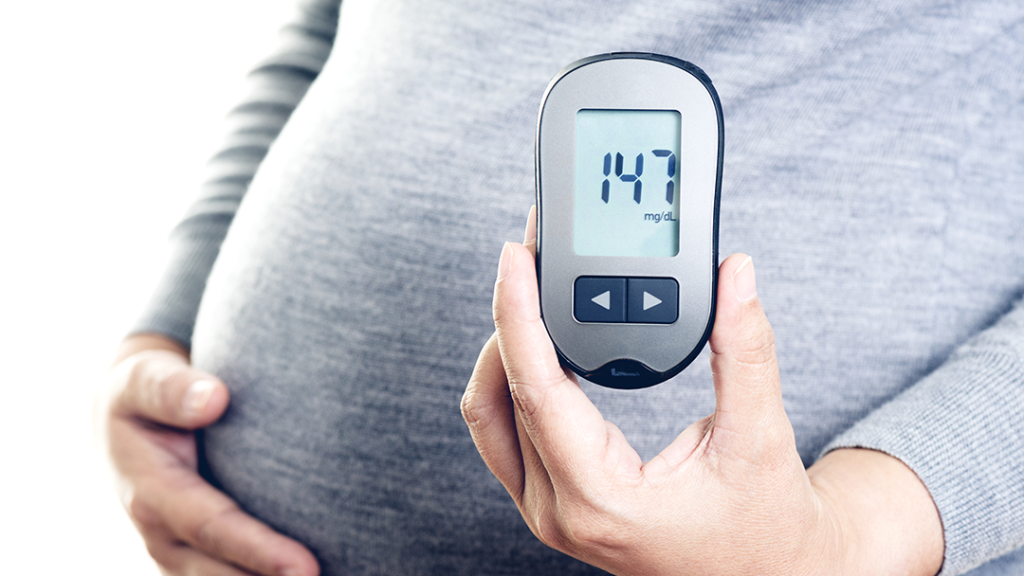Like type 1 diabetes, the jury is still out when it comes to the exact cause of gestational diabetes for some women. For most women, though, the problem occurs during pregnancy.
The placenta makes high levels of various hormones that impair the action of insulin in your cells. This naturally raises your blood sugar. To counteract this, the pancreas then produces insulin. This hormone helps glucose move from your bloodstream into your body’s cells. Which is where the sugar is made into energy.
A modest elevation of your blood sugar is normal during pregnancy. What’s not normal is when the placental hormones invoke a rise in blood sugar to a level that can affect the growth and welfare of your unborn. Gestational diabetes usually manifests during the last half of the pregnancy or even as early as the 20th week.
The following women are more at risk of having gestational diabetes:
- Age greater than 25
- Family history of diabetes
- Overweight or obese
- Non-white (Black, Hispanic, and Asian)
Symptoms

 Usually, there are no noticeable signs of gestational diabetes apart from the high blood sugar level. There are other women, though, who seek health care early to evaluate their chances of getting gestational diabetes when they get pregnant. Once pregnant, the doctor will then check them for gestational diabetes as part of their prenatal care.
Usually, there are no noticeable signs of gestational diabetes apart from the high blood sugar level. There are other women, though, who seek health care early to evaluate their chances of getting gestational diabetes when they get pregnant. Once pregnant, the doctor will then check them for gestational diabetes as part of their prenatal care.
If you developed gestational diabetes, then the doctor will schedule more check-ups for you. There will also be a lot more tests to see if your blood sugar is fluctuating to unmanageable levels. The frequency of these tests will depend on the initial test results that you’ll get.
Risks in Pregnancy

The women who contract gestational diabetes usually deliver healthy babies. However, if you do have gestational diabetes, your baby is at higher risk of the following complications:
1. Low blood sugar (hypoglycemia) – Babies of mothers who have gestational diabetes sometimes develop low blood sugar shortly after birth because of high insulin production on their end. This is very serious since hypoglycemia can induce seizures in the baby.
2. Excessive birth weight – Extra glucose in the mother’s bloodstream crosses the placenta, which then triggers the baby’s pancreas to make extra insulin. This can cause the baby to grow too large, a condition also known as macrosomia. Babies with macrosomia weigh 9 pounds or more and are likely to sustain birth injuries or require a C-section birth.
3. Preterm birth – If a mother has high blood sugar, it can increase her risk of early labor and delivery of the baby before the due date. The doctor can also recommend early delivery because the baby is large (has macrosomia).
4. Respiratory distress syndrome – If the baby is born early, they may experience respiratory distress syndrome – a condition that makes breathing difficult for them.
5. Type 2 diabetes later in life – Babies of mothers who have gestational diabetes have a higher risk of developing obesity and later on type 2 diabetes.
For the mother, it can cause the following complications:
1. High blood pressure and preeclampsia – Alongside high blood sugar, your blood pressure can also shoot up if you have gestational diabetes. Preeclampsia, on the other hand, is a serious complication of pregnancy that causes high blood pressure and other symptoms that can seriously threaten the lives of both mother and baby.
2. Future diabetes – If you have gestational diabetes in your pregnancy, you’re most likely to have it again in a future pregnancy. Also, you’re most likely to develop type 2 diabetes.
If you have gestational diabetes

Alongside constant monitoring of your blood sugar level and frequent trips to your doctor, you can do the following steps to help manage your gestational diabetes:
1. Eat healthy – Ask your doctor to craft a diabetic friendly meal plan for you. Also, you can ask your dietitian to help you make a meal plan yourself. Don’t just surf the Internet for meal plans, what worked for others might not work for you and just make your situation worse.
2. Exercise regularly – Another way to keep your blood sugar under control is regular exercise since this helps balance your food intake. The recommended amount of exercise is at least 30-minutes worth of moderate intensity physical activity.
3. Get tested after pregnancy – Get tested for diabetes 6-12 weeks after giving birth. Most women lose their gestational diabetes after delivery. If it does not go away, then it becomes type 2 diabetes.
If your gestational diabetes does not go away after delivery, you should try taking herbal supplements for blood sugar support like Ampalaya Plus. This herbal supplement will help you manage your blood sugar level with the help of its three superfood ingredients: Ampalaya, Banaba, and Turmeric.



